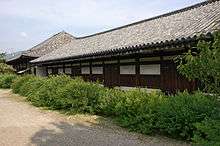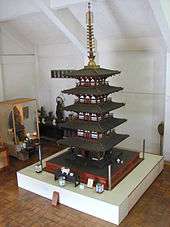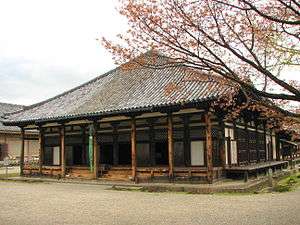Gangō-ji
| Gangō-ji 元興寺 | |
|---|---|
|
Gangō-ji Gokurakubō hondō, a National Treasure | |
| Basic information | |
| Location | 11 Chūin-chō, Nara, Nara Prefecture |
| Affiliation | Shingon-Ritsu |
| Deity | Chikō Mandala |
| Country | Japan |
| Website | http://www.gangoji.or.jp/ |
| Architectural description | |
| Founder | Soga no Umako |
| Completed | 593 |
Gangō-ji (元興寺) is an ancient Buddhist temple, that was once one of the powerful Seven Great Temples, in Nara, Japan.
History
The original foundation of the temple was by Soga no Umako in Asuka, as Asuka-dera. The temple was moved to Nara in 718, following the capital relocation to Heijō-kyō.
Gangō-ji initially held as many as seven halls and pagodas in its precincts, which occupied a wide area within what is now Naramachi, the preserved district of modern Nara city. The original architecture was however, lost over time and notably in fires during the 15th through 19th centuries (Muromachi and Edo periods respectively).[1]
Architecture


The best preserved part of the temple is known as Gangō-ji Gokurakubō (元興寺極楽坊) and belongs to the Shingon-risshū school. This site is a part of a group of temples, shrines and other places in Nara that UNESCO has designated as World Heritage Site "Historic Monuments of Ancient Nara", and holds three national treasures:
- the Hondō (本堂, the main hall), or the Gokurakubō (極楽坊), which is one of the few well-preserved structure of the temple,
- the Zen room
- the miniature (5.5 meters tall) five-story pagoda
Most of the destroyed complex ground has been altered and melded with parts of Naramachi over the course of time. Another small part of the temple remains today as the other Gangō-ji, of a Kegon school but with few remainders in terms of architecture.
Gangō-ji in the Man'yōshū
The Man'yōshū includes a poem attributed to a monk of Gango-ji. This poet laments that, having attained enlightenment, his greater understanding remains unnoticed by others in the streets of Nara. His poem may perhaps bemoan his undervalued condition—and yet, in a modest way, his words transport contemporary readers momentarily back to share his quiet, 8th century perspective:
- A White gem unknown of men --
- Be it so if no one knows!
- Since I myself know its worth
- Although no other --
- Be it so if no one knows!
- -- A monk of the Gango-ji Temple[2]
See also
- Asuka-dera
- Gangōji Garan Engi, a historical text of the temple
- Nanto Shichi Daiji, Seven Great Temples of Nanto.
- List of National Treasures of Japan (temples)
- List of National Treasures of Japan (sculptures)
- For an explanation of terms concerning Japanese Buddhism, Japanese Buddhist art, and Japanese Buddhist temple architecture, see the Glossary of Japanese Buddhism.
Notes
Coordinates: 34°40′41″N 135°49′52″E / 34.67806°N 135.83111°E
